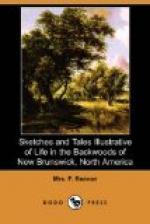I am now just going to walk along the settlement to visit a friend, and if you will accompany me, I shall most willingly be your Asmodeus. A straight and well-worked road runs through the settlement, which is about nine miles in length. This part of the country is particularly hilly, and from where we now stand we have a view of its whole extent. Twenty years ago a blazed track was the only path through the dense forest to where, at its furthest extremity, one adventurous settler had dared to raise his log hut. The older inhabitants, who lived only on the margin of the rivers, laughed at the idea of clearing those high “back lands” where there was neither intervale or rivers, but he heeded them not, and his lonely hut became the nucleus of one of the most flourishing settlements in New Brunswick. The woods have now retreated far back from the road, and at this season the grass and grain are so high that the stumps are all concealed. The scene is very different to the country landscapes of England. There there are square smooth fields enclosed with stone walls, neat white palings, or the hawthorn hedge, scenting the breezes with its balmy “honeysuckle,” or sweet wild rose—song-birds filling the air with melody, and stately castles, towering o’er the peasant’s lowly home, while far as the eye can reach ’twill rest but on some fair village dome or farm. Here the worm or zigzag fence runs round the irregularly-shaped clearings, in the same rustic garb it wore when a denizen of the forest. The wild flowers here have no perfume, but the raspberries, which grow luxuriantly in the spaces made by the turnings of the fences, have a sweet smell, and there is a breath which tells of the rich strawberry far down among the shadowy grass. The birds during the hot months of summer have no song, but there are numbers of them, and of the brightest plumage. The fairy humming-bird, often in size no larger than a bee, gleams through the air like a flower with wings, and the bald eagle sits majestically on the old grey pines, which stand like lone monuments of the past, the storms and the lightnings having ages ago wreaked their worst upon them, and bereft them of life and limb, yet still they stand, all lofty and unscathed by the axe or the fire which has laid the younger forest low. The dwellings, either the primitive log-hut, the first home of the settler, or the more stately frame-buildings, stand each near the road, on the verge of its own clearing, which reaches back to where the dark woods form a back-ground to the scene. These stretch far and wide over the land, save where appears, amid their density, some lonely settlement or improvement of adventurous emigrant. Those little spots, of how much importance to their owners, yet seem as nothing amid the vast forest. Each dwelling in this country is in itself a theme for study and interest. Here, on one side, is the home of an English settler—amid all the bustle and chopping and burning of a new farm,




